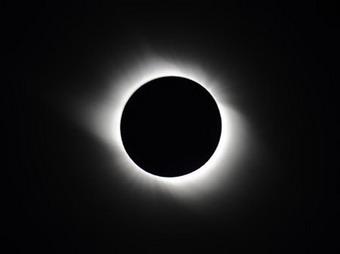People in the Xinjiang Uygur Autonomous Region were treated to China's first total solar eclipse of the 21st century. Locals and tourists gathered to watch the rare event. The eclipse was also seen in other parts of China, and other countries.
|

|
|
Photo taken at 7:15 pm (1115 GMT) on Aug. 1, 2008 shows the total solar eclipse at an observation station in Jinta County of Jiuquan City, northwest China's Gansu Province. The total solar eclipse, the first that can be viewed in China in the new century, occured on Friday. [Xinhua]
|
Millions of people across parts of Asia gathered to watch a total solar eclipse along the ancient Silk Road.
Thousands of sky gazers from more than 10 countries and regions gathered at an observation square in Yiwu County, Xinjiang, to see the eclipse. Officials said the area provided the best viewpoint in China.
The total solar eclipse occurred about 6pm Beijing time.
The whole solar eclipse lasted for close to two hours, but the Sun was only totally blocked by the moon for about two minutes. The eclipse entered China over the Altay Mountains along the border with Russia and Mongolia. Its path then travelled through Xinjiang, Gansu, Inner Mongolia, and Ningxia.
 |
|
The combination photo shows the total solar eclipse occured in Jinta County of Jiuquan City, northwest China's Gansu Province, on Aug. 1, 2008. The total solar eclipse, the first that can be viewed in China in the new century, occured on Friday. [Xinhua]
|
The eclipse also occurred in Shaanxi, Shanxi and Henan provinces, but at that time the sun was low in the sky that viewing conditions were poor.
Besides Xinjiang and Gansu, people in several other regions, such as Hong Kong, could see a total or partial eclipse.
Jeff Askew, UK amateur astronomer, said, "Two years ago, the total solar eclipse in south Africa was fully cloudy, so this one is much much better with nice sunshine. We observe everything. "
Enthusiasts in Russia also gazed at skies as the solar eclipse became visible in Siberia.
It was also seen in Afghanistan.